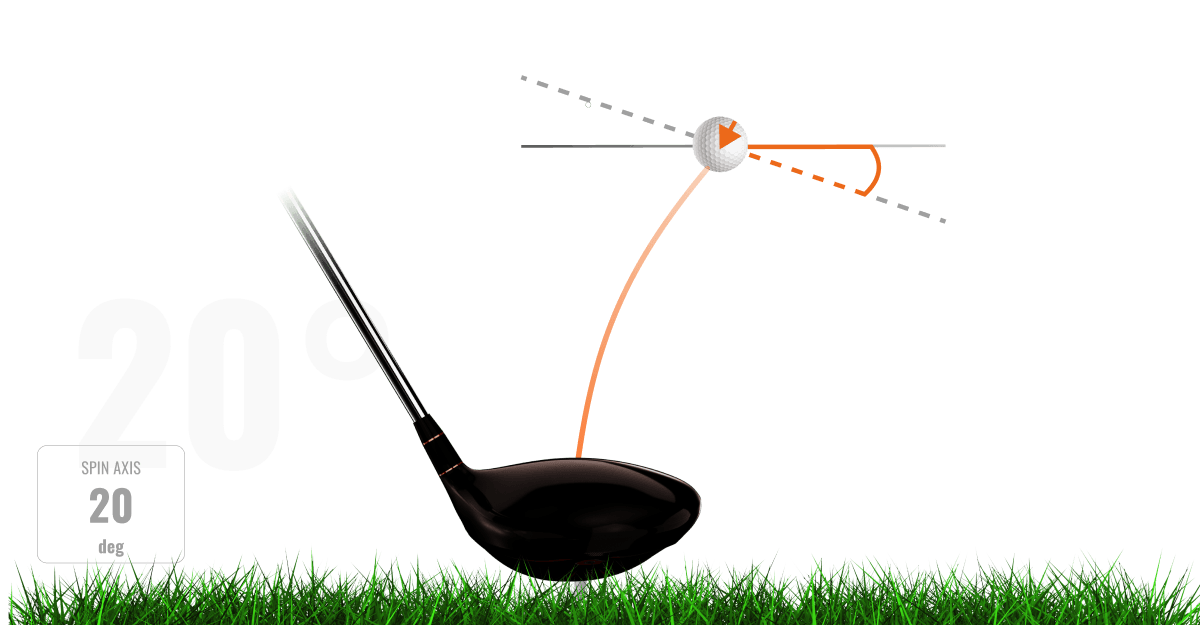What is Spin Axis?


Representing the amount of curvature of a golf shot, a Spin Axis between -2 and 2 can be considered a straight shot
A negative Spin Axis represents a ball curving to the left, a positive Spin Axis represents a ball curving to the right, and a zero Spin Axis represents a shot that has no curvature.
Spin Axis is determined at impact and should remain the same throughout the flight of the ball. Even though wind may ‘push’ the ball in different directions, the Spin Axis will remain unchanged. Spin Axis is measured relative to the horizon.
The Spin Axis can be associated to the wings of an airplane. If the wings of an airplane are parallel to the ground, this would represent a zero Spin Axis and the plane would fly straight. If the wings were banked/tilted to the left (right wing higher than left wing), this would represent a negative Spin Axis and the plane would bank/curve to the left. And the opposite holds true if the wings are banked/tilted to the right.
In general, a Spin Axis between -2 and 2 can be considered a straight shot. Under normal conditions, it would be difficult to see curvature on a shot with a Spin Axis between -2 and 2. The higher the number of the Spin Axis, the more curvature that should be visible.
To learn more, watch former LPGA Tour pro Julieta Granada work the ball both ways by controlling her spin axis.
Technical Definition:
Spin Axis – The tilt angle relative to the horizon of the golf ball’s resulting rotational axis immediately after separation from the club face (post impact).
Remark: Positive angles refer to a ball curving to the right (negative refer to a ball curving to the left).
Right-handed golfer
Large negative Spin Axis can be described as a hook
Small negative Spin Axis can be described as a draw
Small positive Spin Axis can be described as a fade
Large positive Spin Axis can be described as a slice
Left-handed golfer
Large negative Spin Axis can be described as a slice
Small negative Spin Axis can be described as a fade
Small positive Spin Axis can be described as a draw
Large positive Spin Axis can be described as a hook
Indoor vs Outdoor Mode
Note: When using Trackman in ‘outdoor’ mode, the first ~30 yards of ball flight are used to determine the Spin Axis value. However, since the Spin Axis does not change during the ball flight, this measurement is considered to be made after separation from the club face.
When using Trackman in ‘indoor’ mode, the club delivery measurements (spin loft and face to path) are used to calculate the Spin Axis.
Spin Axis examples
Optimized 150 Yard Shot
-2 Spin Axis ≈ 2.2 yards of left curvature
-10 Spin Axis ≈ 11 yards of left curvature
2 Spin Axis ≈ 2.2 yards of right curvature
10 Spin Axis ≈ 11 yards of right curvature
Optimized 200 Yard Shot
-2 Spin Axis ≈ -3 yards of left curvature
-10 Spin Axis ≈ -15 yards of left curvature
2 Spin Axis ≈ 3 yards of right curvature
10 Spin Axis ≈ 15 yards of right curvature
The standard assumption for Spin Axis is zero for all clubs. It is a standard assumption that the ball has no curvature (zero Spin Axis).
Read what our Trackman University Masters say about Spin Axis…
“I use Spin Axis in conjunction with face angle and club path to determine where the student is hitting the ball on the face of the club. If the face to path number is positive and Spin Axis is negative, I know that the student hit the ball towards the toe side of the center of gravity of the club head.”

Mark Anderson
Philadelphia Cricket Club, PA, US
“Spin Axis allows me to see what type of shot shape someone typically plays. Spin Axis determines if the ball is drawing by a negative number and fading by a positive number. I can see if their natural shot is what I would consider playable. I consider a single digit Spin Axis value to be a playable ball flight.”

Ryan Johnson
Carl’s Golfland, MI, US
“Spin Axis is a great measure for centeredness of contact when used in conjunction with face to path. Spin Axis gives the coach great feedback to a player’s striking tendencies.”

Hugh Marr
Premium Golf Consulting, UK